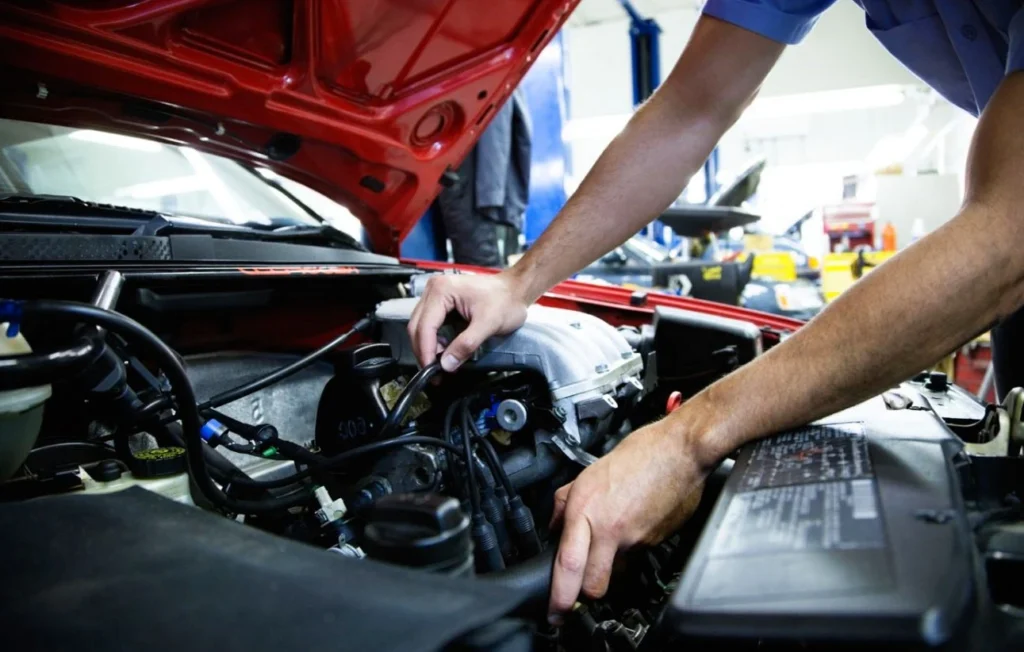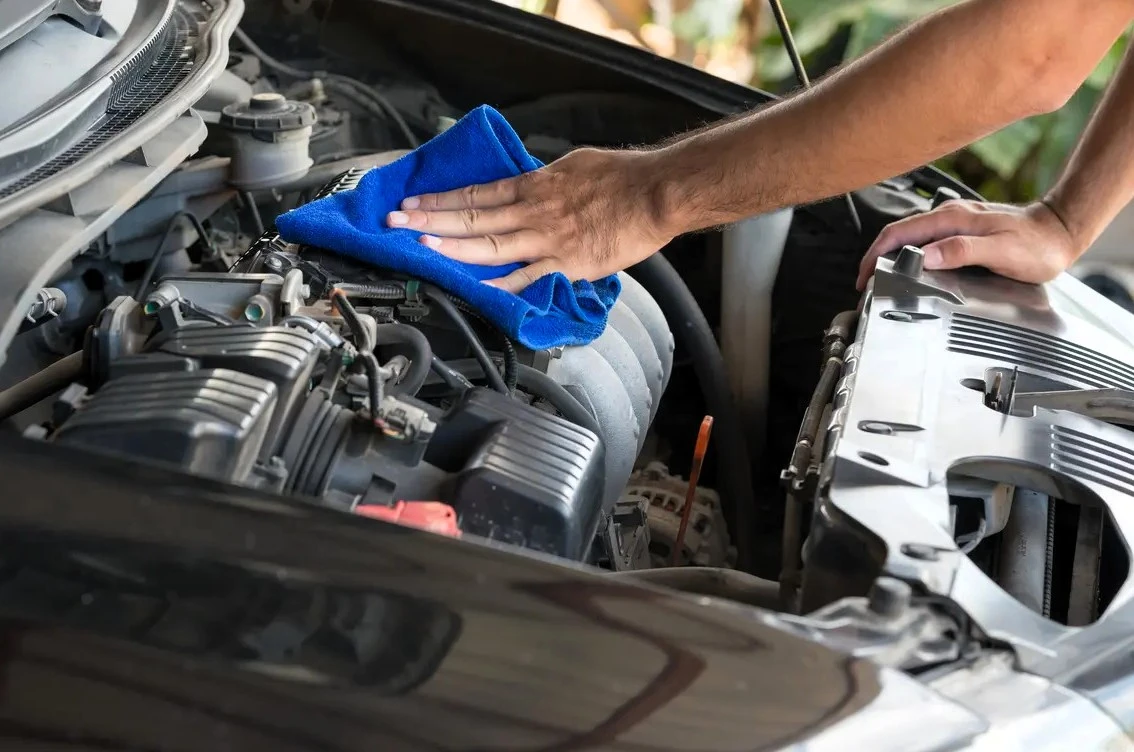Why You Should Clean Your Car Engine
Although car engine cleaning is not a common part of maintenance, it should be. When the engine is clean, your vehicle runs better and stays cooler. Dirt, grease, and oil on the engine can hold heat, cause rubber parts to break down and make it hard to see any leaks or damage. Auto engine cleaning helps important parts last longer.
Also, a tidy engine bay helps you work more easily when you are under the hood. Problems are easily found by mechanics and potential buyers will notice how the vehicle has been maintained. It is not only more attractive but also works better and lasts for a longer time.
Is Cleaning the Engine Safe?
Many drivers worry that how to clean car engine safely may harm sensitive electronics. That fear is valid but avoidable. When done correctly, engine cleaning is safe and beneficial. Always allow the engine to cool completely before starting, and take time to prepare the area.
By covering key electrical components and using low-pressure rinsing or waterless methods, the risk of damage is minimized. Follow the correct process step by step, and you’ll have a clean engine without any harm done.
Read More – How to Clean Car Windows Perfectly?
Essential Tools and Products for the Job
Gather all the tools and products that you are going to use for auto engine cleaning before you start. It will make things much simpler and faster. If you do not use the correct cleaning materials or miss using safety gear, the results may be bad or cause damage.
Here’s a simple list to get you started:
- Gunk Engine Degreaser: This popular cleaner breaks down grease quickly and is safe for rubber and metal surfaces.
- Chemical Guys Signature Series Engine Cleaner: Ideal for how to clean car engine without water and spot detailing; safe for modern engine bays.
- Soft Bristle Detailing Brush: Perfect for gently loosening grime without scratching delicate surfaces.
- Microfiber Towels: These help with wiping and drying, and they leave no lint behind.
- Plastic Wrap or Foil: Use this to shield electrical parts like the alternator, battery terminals, and fuse boxes.
- Spray Bottle or Low-Pressure Hose: Use light sprays only — never pressure washers.
Safety gear like gloves and goggles is also recommended. These keep your hands and eyes protected from chemicals.
Step 1: Let the Engine Cool Down
Do not clean an engine that is still hot. It is dangerous for you and also makes your cleaning products less effective. Don’t start for at least 30–45 minutes after the engine has been turned off. It should feel comfortable to touch your breasts.
Hot surfaces can make water or cleaners dry too fast, leaving behind residue or causing cracks because of the sudden change in temperature. Having a cool engine at the start gives you the best and safest results.
Step 2: Disconnect the Battery and Cover Key Components
Unplug the negative battery terminal so that no short circuits can occur by accident. Wrapping the battery, alternator, air intake, and wires or sensors with plastic or foil will help. It is very important to do this step to protect your electronics from getting wet or covered in cleaner.
Check that the coverings are properly attached and sealed. Make sure to do this — not cleaning the right parts can lead to electrical faults or problems with how the car runs later.
Step 3: Remove Loose Debris First
Always clean out any dry material such as leaves, dust, or dirt before you use liquid products. You can use a vacuum, compressed air, or a brush to clean the area around the edges, under the hood, and the area near the battery tray.
This stops mud from forming after the automotive degreaser is used. It also works particularly well for deep cleaning since it can easily reach the hard-to-notice corners.
Step 4: Apply Engine Degreaser
Spray an engine degreaser on the dirty parts, but do not spray it on any parts covered by electrical components. Leave the stain for 3 to 5 minutes to let the detergent work on the grease and oil. Clean the valve covers, hoses, caps, and any parts that look dirty.
Try not to spray more paint than you need. A smooth and uniform application is most effective. This step makes it possible for the product to do most of the work, so scrubbing becomes easier and more effective.
Step 5: Scrub Gently and Thoroughly
Use your soft bristle brush to scrub areas where the degreaser was applied. Move in small circles, especially on stuck-on grime and oily residue. This process takes a few minutes but makes a big difference in your final result.
Avoid using metal or hard brushes, which can scratch surfaces or loosen wires. Take your time and focus on the most soiled spots first, then go over the rest for an even finish.
Step 6: Rinse with Care
Spray the plant with a water bottle or use a hose with only a little pressure. Wash the degreaser off the engine, starting with the back and moving toward the front. Spray the engine gently to get rid of any remaining cleaner.
Dry the surface with Microfiber Towels right away. You can let the engine air dry, but if you wipe it, you avoid water spots and finish the process faster.
Step 7: Remove Covers and Reconnect the Battery
When everything is clean and dry, take away the plastic or foil covering the electrical parts. Check that water has not found its way under the wraps. Attach the battery terminal again and listen for any unusual sounds or smells when you start the engine.
Allow the car to sit with the engine running for a short period. It helps dry out the remaining moisture with heat and lets you check for any problems.
How to Clean Car Engine Bay

How to clean car engine bay is about maintaining both performance and appearance. Begin by dusting off the surface using a soft brush. Follow up with a quality degreaser, apply evenly, and scrub as needed. Rinse gently and avoid oversaturating.
Focus on visible areas like valve covers, belts, and the battery tray. Always dry thoroughly with Microfiber Towels and make sure no water reaches sensitive areas. A clean engine bay cleaning boosts resale value and makes future maintenance easier.
How to Clean Car Engine Without Water
How to clean car engine without water is great for those who live in cold climates or want a safer approach. Use a foam engine cleaner like Chemical Guys Signature Series, which lifts dirt without needing to rinse.
Spray the foam directly onto dirty parts, let it sit for a few minutes, then wipe clean with Microfiber Towels. Repeat in small sections. This method is ideal for modern engines where water exposure might cause issues.
Pro Tips for Maintaining a Clean Engine
Once your engine is clean, you’ll want to keep it that way with minimal effort. Here are a few easy ways to maintain it:
- Wipe it down every couple of weeks using a dry microfiber cloth
- Spot clean small oil drips or spills as soon as you notice them
- Use engine protectant spray to restore shine and add a layer of protection
- Avoid parking under trees that drop leaves, sap, or pollen
- Inspect for signs of leaks during regular oil checks
These habits help extend the life of your car engine cleaning job and protect the engine components over time.
What to Avoid While Cleaning
Mistakes during how to clean car engine procedures can be costly. Avoid these common errors:
- Never use high-pressure water, which can damage parts
- Don’t clean a hot engine — wait until it cools down
- Avoid using dish soap or harsh cleaners not meant for cars
- Don’t forget to cover the battery, alternator, and sensors
- Don’t scrub too hard — gentle pressure is enough with the right products
Being cautious ensures a safe and effective car engine cleaning process every time.
Final Thoughts
Learning how to clean car engine without water or with water might sound technical, but with the right method, anyone can do it like a pro. Whether you choose the water method or prefer a waterless approach, both are effective when done properly. Stick to the right tools, follow a step-by-step process, and use quality products like Gunk, Chemical Guys, and Microfiber Towels. Your vehicle will not only look better but run smoother, and you’ll stay ahead of potential engine problems before they become expensive repairs.

